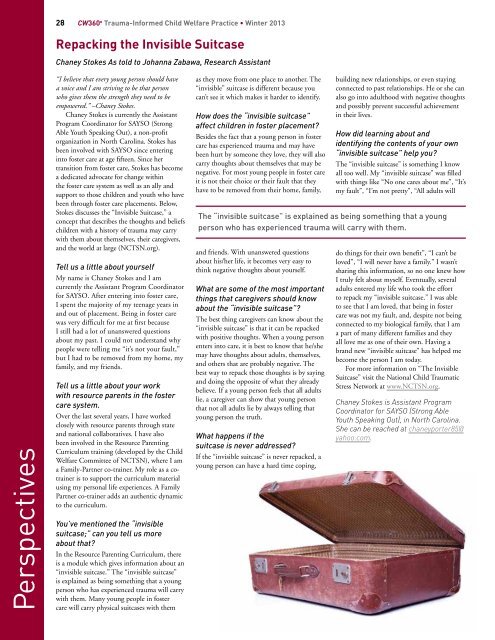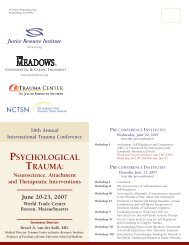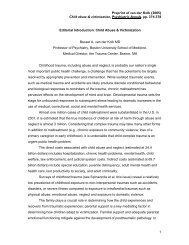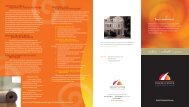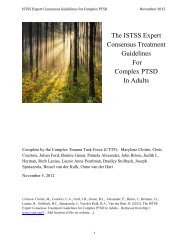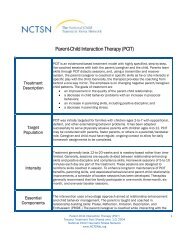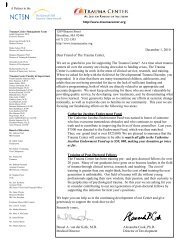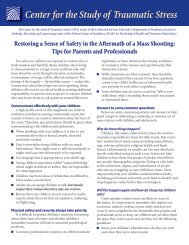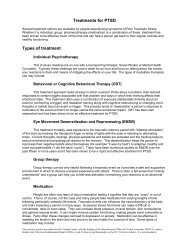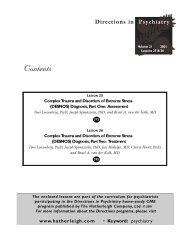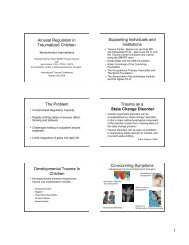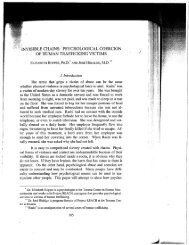in Child Welfare - The Trauma Center
in Child Welfare - The Trauma Center
in Child Welfare - The Trauma Center
You also want an ePaper? Increase the reach of your titles
YUMPU automatically turns print PDFs into web optimized ePapers that Google loves.
28 CW360 o <strong>Trauma</strong>-Informed <strong>Child</strong> <strong>Welfare</strong> Practice • W<strong>in</strong>ter 2013Repack<strong>in</strong>g the Invisible SuitcaseChaney Stokes As told to Johanna Zabawa, Research AssistantPerspectives“I believe that every young person should havea voice and I am striv<strong>in</strong>g to be that personwho gives them the strength they need to beempowered.” –Chaney Stokes.Chaney Stokes is currently the AssistantProgram Coord<strong>in</strong>ator for SAYSO (StrongAble Youth Speak<strong>in</strong>g Out), a non-profitorganization <strong>in</strong> North Carol<strong>in</strong>a. Stokes hasbeen <strong>in</strong>volved with SAYSO s<strong>in</strong>ce enter<strong>in</strong>g<strong>in</strong>to foster care at age fifteen. S<strong>in</strong>ce hertransition from foster care, Stokes has becomea dedicated advocate for change with<strong>in</strong>the foster care system as well as an ally andsupport to those children and youth who havebeen through foster care placements. Below,Stokes discusses the “Invisible Suitcase,” aconcept that describes the thoughts and beliefschildren with a history of trauma may carrywith them about themselves, their caregivers,and the world at large (NCTSN.org).Tell us a little about yourselfMy name is Chaney Stokes and I amcurrently the Assistant Program Coord<strong>in</strong>atorfor SAYSO. After enter<strong>in</strong>g <strong>in</strong>to foster care,I spent the majority of my teenage years <strong>in</strong>and out of placement. Be<strong>in</strong>g <strong>in</strong> foster carewas very difficult for me at first becauseI still had a lot of unanswered questionsabout my past. I could not understand whypeople were tell<strong>in</strong>g me “it’s not your fault,”but I had to be removed from my home, myfamily, and my friends.Tell us a little about your workwith resource parents <strong>in</strong> the fostercare system.Over the last several years, I have workedclosely with resource parents through stateand national collaboratives. I have alsobeen <strong>in</strong>volved <strong>in</strong> the Resource Parent<strong>in</strong>gCurriculum tra<strong>in</strong><strong>in</strong>g (developed by the <strong>Child</strong><strong>Welfare</strong> Committee of NCTSN), where I ama Family-Partner co-tra<strong>in</strong>er. My role as a cotra<strong>in</strong>eris to support the curriculum materialus<strong>in</strong>g my personal life experiences. A FamilyPartner co-tra<strong>in</strong>er adds an authentic dynamicto the curriculum.You’ve mentioned the “<strong>in</strong>visiblesuitcase;” can you tell us moreabout that?In the Resource Parent<strong>in</strong>g Curriculum, thereis a module which gives <strong>in</strong>formation about an“<strong>in</strong>visible suitcase.” <strong>The</strong> “<strong>in</strong>visible suitcase”is expla<strong>in</strong>ed as be<strong>in</strong>g someth<strong>in</strong>g that a youngperson who has experienced trauma will carrywith them. Many young people <strong>in</strong> fostercare will carry physical suitcases with themas they move from one place to another. <strong>The</strong>“<strong>in</strong>visible” suitcase is different because youcan’t see it which makes it harder to identify.How does the “<strong>in</strong>visible suitcase”affect children <strong>in</strong> foster placement?Besides the fact that a young person <strong>in</strong> fostercare has experienced trauma and may havebeen hurt by someone they love, they will alsocarry thoughts about themselves that may benegative. For most young people <strong>in</strong> foster careit is not their choice or their fault that theyhave to be removed from their home, family,and friends. With unanswered questionsabout his/her life, it becomes very easy toth<strong>in</strong>k negative thoughts about yourself.What are some of the most importantth<strong>in</strong>gs that caregivers should knowabout the “<strong>in</strong>visible suitcase”?<strong>The</strong> best th<strong>in</strong>g caregivers can know about the“<strong>in</strong>visible suitcase” is that it can be repackedwith positive thoughts. When a young personenters <strong>in</strong>to care, it is best to know that he/shemay have thoughts about adults, themselves,and others that are probably negative. <strong>The</strong>best way to repack those thoughts is by say<strong>in</strong>gand do<strong>in</strong>g the opposite of what they alreadybelieve. If a young person feels that all adultslie, a caregiver can show that young personthat not all adults lie by always tell<strong>in</strong>g thatyoung person the truth.What happens if thesuitcase is never addressed?If the “<strong>in</strong>visible suitcase” is never repacked, ayoung person can have a hard time cop<strong>in</strong>g,build<strong>in</strong>g new relationships, or even stay<strong>in</strong>gconnected to past relationships. He or she canalso go <strong>in</strong>to adulthood with negative thoughtsand possibly prevent successful achievement<strong>in</strong> their lives.How did learn<strong>in</strong>g about andidentify<strong>in</strong>g the contents of your own“<strong>in</strong>visible suitcase” help you?<strong>The</strong> “<strong>in</strong>visible suitcase” is someth<strong>in</strong>g I knowall too well. My “<strong>in</strong>visible suitcase” was filledwith th<strong>in</strong>gs like “No one cares about me”, “It’smy fault”, “I’m not pretty”, “All adults will<strong>The</strong> “<strong>in</strong>visible suitcase” is expla<strong>in</strong>ed as be<strong>in</strong>g someth<strong>in</strong>g that a youngperson who has experienced trauma will carry with them.do th<strong>in</strong>gs for their own benefit”, “I can’t beloved”, “I will never have a family.” I wasn’tshar<strong>in</strong>g this <strong>in</strong>formation, so no one knew howI truly felt about myself. Eventually, severaladults entered my life who took the effortto repack my “<strong>in</strong>visible suitcase.” I was ableto see that I am loved, that be<strong>in</strong>g <strong>in</strong> fostercare was not my fault, and, despite not be<strong>in</strong>gconnected to my biological family, that I ama part of many different families and theyall love me as one of their own. Hav<strong>in</strong>g abrand new “<strong>in</strong>visible suitcase” has helped mebecome the person I am today.For more <strong>in</strong>formation on “<strong>The</strong> InvisibleSuitcase” visit the National <strong>Child</strong> <strong>Trauma</strong>ticStress Network at www.NCTSN.org.Chaney Stokes is Assistant ProgramCoord<strong>in</strong>ator for SAYSO (Strong AbleYouth Speak<strong>in</strong>g Out), <strong>in</strong> North Carol<strong>in</strong>a.She can be reached at chaneyporter85@yahoo.com.


